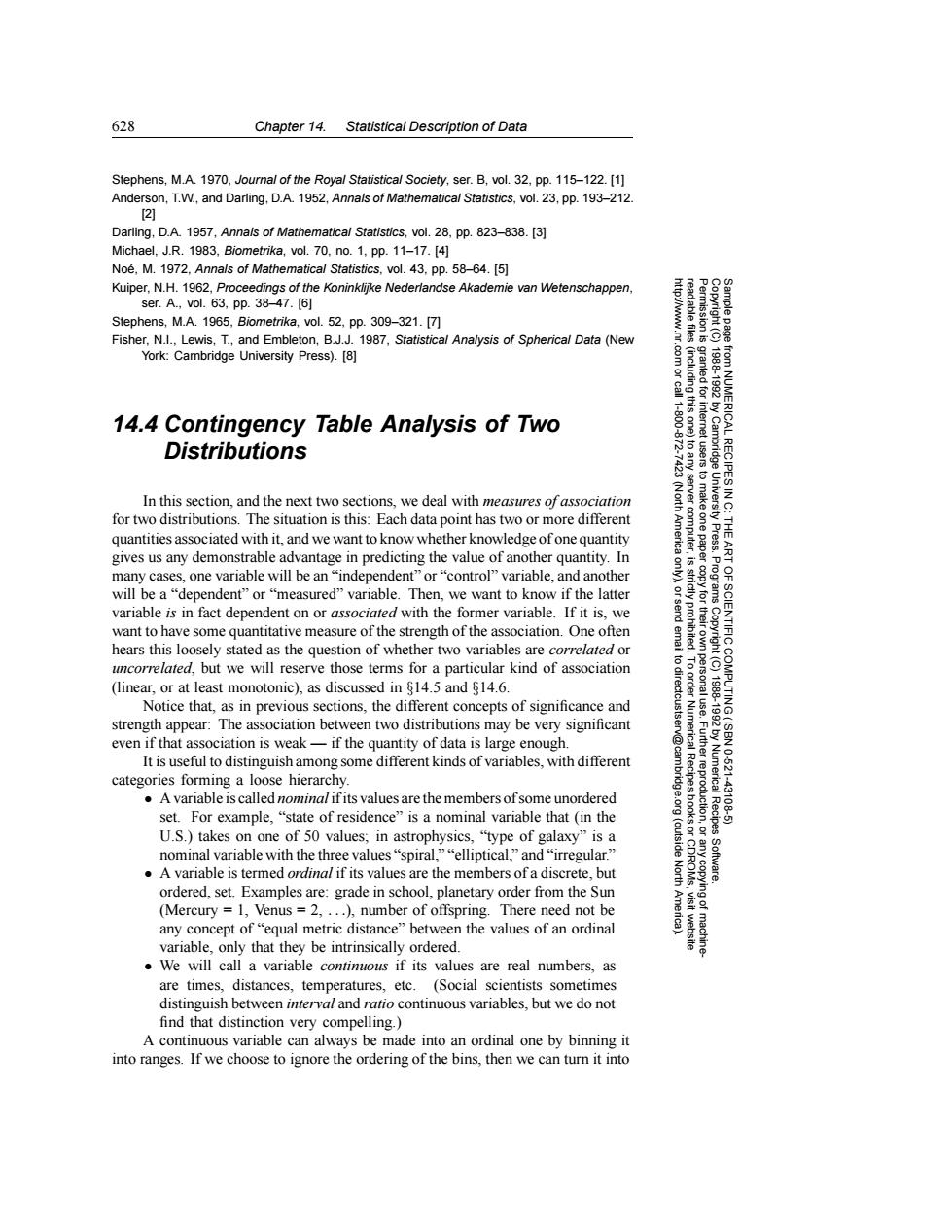正在加载图片...

628 Chapter 14.Statistical Description of Data Stephens,M.A.1970,Journal of the Royal Statistical Society,ser.B,vol.32,pp.115-122.[1] Anderson,T.W.,and Darling,D.A.1952,Annals of Mathematica/Statistics,vol.23,pp.193-212. [2) Darling,D.A.1957,Annals of Mathematical Statistics,vol.28,pp.823-838.[3] Michael,J.R.1983,Biometrika,vol.70,no.1,pp.11-17.[4] Noe,M.1972,Annals of Mathematical Statistics,vol.43,pp.58-64.[5] Kuiper,N.H.1962,Proceedings of the Koninklijike Nederlandse Akademie van Wetenschappen, ser.A,vol.63,pp.38-47.[6] Stephens,M.A.1965,Biometrika,vol.52,pp.309-321.[7] Fisher,N.I.,Lewis,T.,and Embleton,B.J.J.1987,Statistical Analysis of Spherical Data (New York:Cambridge University Press).[8] 14.4 Contingency Table Analysis of Two Distributions In this section,and the next two sections,we deal with measures ofassociation 毫2ae时 令 for two distributions.The situation is this:Each data point has two or more different quantities associated with it,and we want to know whether knowledge of one quantity gives us any demonstrable advantage in predicting the value of another quantity.In many cases,one variable will be an"independent"or"control"variable,and another will be a"dependent"or"measured"variable.Then,we want to know if the latter Programs variable is in fact dependent on or associated with the former variable.If it is,we want to have some quantitative measure of the strength of the association.One often OF SCIENTIFIC hears this loosely stated as the question of whether two variables are correlated or uncorrelated,but we will reserve those terms for a particular kind of association (linear.or at least monotonic).as discussed in $14.5 and 814.6. Notice that,as in previous sections,the different concepts of significance and strength appear:The association between two distributions may be very significant even if that association is weak-if the quantity of data is large enough. It is useful to distinguish among some different kinds of variables,with different 10621 categories forming a loose hierarchy. A variable is called nominal ifits values are the members of some unordered Numerical Recipes 43106 set.For example,"state of residence"is a nominal variable that (in the U.S.)takes on one of 50 values;in astrophysics,"type of galaxy"is a nominal variable with the three values“spiral,.”“elliptical,.”and“irregular.. (outside A variable is termed ordinal if its values are the members of a discrete,but Software. ordered,set.Examples are:grade in school,planetary order from the Sun (Mercury =1,Venus=2,...),number of offspring.There need not be any concept of"equal metric distance"between the values of an ordinal variable,only that they be intrinsically ordered. We will call a variable continuous if its values are real numbers,as are times,distances,temperatures,etc.(Social scientists sometimes distinguish between interval and ratio continuous variables,but we do not find that distinction very compelling.) A continuous variable can always be made into an ordinal one by binning it into ranges.If we choose to ignore the ordering of the bins,then we can turn it into628 Chapter 14. Statistical Description of Data Permission is granted for internet users to make one paper copy for their own personal use. Further reproduction, or any copyin Copyright (C) 1988-1992 by Cambridge University Press. Programs Copyright (C) 1988-1992 by Numerical Recipes Software. Sample page from NUMERICAL RECIPES IN C: THE ART OF SCIENTIFIC COMPUTING (ISBN 0-521-43108-5) g of machinereadable files (including this one) to any server computer, is strictly prohibited. To order Numerical Recipes books or CDROMs, visit website http://www.nr.com or call 1-800-872-7423 (North America only), or send email to directcustserv@cambridge.org (outside North America). Stephens, M.A. 1970, Journal of the Royal Statistical Society, ser. B, vol. 32, pp. 115–122. [1] Anderson, T.W., and Darling, D.A. 1952, Annals of Mathematical Statistics, vol. 23, pp. 193–212. [2] Darling, D.A. 1957, Annals of Mathematical Statistics, vol. 28, pp. 823–838. [3] Michael, J.R. 1983, Biometrika, vol. 70, no. 1, pp. 11–17. [4] No´e, M. 1972, Annals of Mathematical Statistics, vol. 43, pp. 58–64. [5] Kuiper, N.H. 1962, Proceedings of the Koninklijke Nederlandse Akademie van Wetenschappen, ser. A., vol. 63, pp. 38–47. [6] Stephens, M.A. 1965, Biometrika, vol. 52, pp. 309–321. [7] Fisher, N.I., Lewis, T., and Embleton, B.J.J. 1987, Statistical Analysis of Spherical Data (New York: Cambridge University Press). [8] 14.4 Contingency Table Analysis of Two Distributions In this section, and the next two sections, we deal with measures of association for two distributions. The situation is this: Each data point has two or more different quantities associated with it, and we want to know whether knowledge of one quantity gives us any demonstrable advantage in predicting the value of another quantity. In many cases, one variable will be an “independent” or “control” variable, and another will be a “dependent” or “measured” variable. Then, we want to know if the latter variable is in fact dependent on or associated with the former variable. If it is, we want to have some quantitative measure of the strength of the association. One often hears this loosely stated as the question of whether two variables are correlated or uncorrelated, but we will reserve those terms for a particular kind of association (linear, or at least monotonic), as discussed in §14.5 and §14.6. Notice that, as in previous sections, the different concepts of significance and strength appear: The association between two distributions may be very significant even if that association is weak — if the quantity of data is large enough. It is useful to distinguish among some different kinds of variables, with different categories forming a loose hierarchy. • A variable is called nominal if its values are the members of some unordered set. For example, “state of residence” is a nominal variable that (in the U.S.) takes on one of 50 values; in astrophysics, “type of galaxy” is a nominal variable with the three values “spiral,” “elliptical,” and “irregular.” • A variable is termed ordinal if its values are the members of a discrete, but ordered, set. Examples are: grade in school, planetary order from the Sun (Mercury = 1, Venus = 2, ...), number of offspring. There need not be any concept of “equal metric distance” between the values of an ordinal variable, only that they be intrinsically ordered. • We will call a variable continuous if its values are real numbers, as are times, distances, temperatures, etc. (Social scientists sometimes distinguish between interval and ratio continuous variables, but we do not find that distinction very compelling.) A continuous variable can always be made into an ordinal one by binning it into ranges. If we choose to ignore the ordering of the bins, then we can turn it into